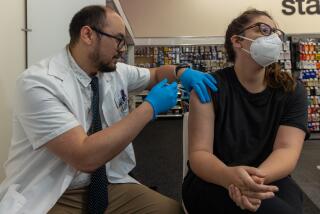Swine flu no worse than seasonal flu for most victims, study says
- Share via
More children and young adults were hospitalized as a result of pandemic H1N1 influenza than is normal for seasonal flu, but that was simply because those groups were disproportionately infected, not because the symptoms were worse, researchers said Tuesday. The pandemic flu, commonly known as swine flu, did cause more pneumonia than seasonal flu, but overall the symptoms were about the same, researchers from the Marshfield Clinic Research Foundation in Marshfield, Wisc. reported in the Journal of the American Medical Assn. The researchers were not, however, able to draw any conclusions about pregnant women and those with chronic health conditions, groups that were considered at especially high risk.
Swine flu was unusual because it was highly active during the spring and summer months when seasonal flu is normally dormant. The Centers for Disease Control and Prevention estimated that between 43 million and 89 million cases occurred in the United States, with an estimated 274,000 hospitalizations and 12,470 deaths. The outbreak was termed a pandemic because the virus appeared in so many locations throughout the world, not because it was considered more virulent than seasonal flu. Although researchers feared that the virus could mutate to become more lethal, that never happened, and the virus continued to cause only mild disease. The World Health Organization officially declared the pandemic over in August. Large amounts of vaccine directed against swine flu were never used because of public complacency about the virus. A vaccine against the virus is included in this year’s seasonal flu shot, however.
The Marshfield Clinic provides healthcare for nearly everyone in the surrounding communities, and Dr. Edward A. Belongia and his colleagues have been tracking all the flu patients there since 2007 for a study to monitor the efficacy of vaccination. They identified 545 people with swine flu, 221 with seasonal H1N1 flu and 632 with seasonal H3N2 flu, which generally affects older people more severely.
They found:
-- 4% of adults with swine flu were hospitalized, compared to 2.3% of those with seasonal H1N1 and 4.5% of those with H3N2.
-- 1.5% of children with swine flu were hospitalized, compared to 3.7% with seasonal H1N1 and 3.1% of those with H3N2.
-- 4% of adults with swine flu had pneumonia, compared to 2.3% of those with seasonal H1N1 and 1.1% of those with H3N2.
-- 2.5% of children with swine flu had pneumonia, compared to 1.5% of those with seasonal H1N1 and 2% of those with seasonal H3N2.
Patients with swine flu generally reported that their symptoms did not feel any worse than those with seasonal flu.
“We found that children were disproportionately affected by 2009 H1N1 infections, but the perceived severity of symptoms and risk of serious outcomes (pneumonia or hospital admissions) were not increased in children relative to seasonal influenza A viruses,” the authors concluded.
-- Thomas H. Maugh II / Los Angeles Times






